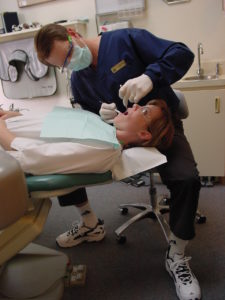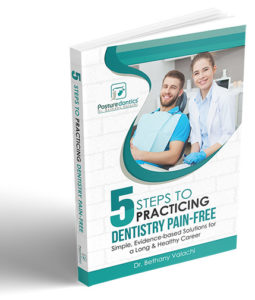-Dr. Bethany Valachi-
You’ve had a tough day in the operatory, the sun is out, your back is aching, and the green is calling. What could be better than a game of golf to work the aches out? For some dentists…just about anything!
It’s no secret that over 50% of dentists experience chronic low back pain1. So prevalent is the problem, low back pain has become a cornerstone that many dental manufacturers use to market their ergonomic products to dentists. Yet the very sport that most dentists flock to after work, on weekends or at conferences reports low back pain as the most frequent area of pain and injuries among its enthusiasts. A staggering 62% of amateur golfers cited the low back as the area most frequently injured2. Is it possible that dentist’s favorite sport may be exacerbating the ‘weakest link’ in their body?

![]()
![]()
![]() Many dentists’ favorite sport may exacerbate certain muscle imbalances to which dentists are predisposed, leading to low back pain.
Many dentists’ favorite sport may exacerbate certain muscle imbalances to which dentists are predisposed, leading to low back pain.
The good news is that addressing two risk factors that contribute to low back pain in both dentists & golfers may help golfing dentists more comfortably continue the sport they love. These risk factors are flexed spinal posture and poor spinal rotation away from the patient, or toward the backswing side.
The first risk factor, flexed spinal posture is a common position assumed by many dentists and often difficult to avoid due to varying patient size, poor patient tolerance to reclining, location of the occlusal surface, etc. Flexing the spine forward over the patient is a risk factor for muscle strains, trigger points, facet arthopathy and disc degeneration or herniation that can result in low back pain1. Golfers with low back pain tend to flex their spines more when addressing the ball3, which tends to limit the amount of spinal rotation.
This risk factor is easily corrected with proper patient and operator positioning and specific training of one muscle group that research shows help prevent low back pain in golfers and dentists.
The second risk factor is spinal rotation. The body mechanics of right handed golfers somewhat simulates dentists in the operatory: leaning forward, and rotating to the left. Golfers with low back pain tend to have less flexibility with trunk rotation3, which can cause compensatory movements in the spine, hips or shoulders.2 One study showed that right handed dentists leaned forward, to the right & rotated to the left for two-thirds of their working hours 6. Dentists who repeatedly postured this way had the highest incidence of low back pain, and also tend to have less spinal rotation to the right (away from the patient). Spinal rotation is also difficult for most dentists to avoid in the operatory. Repeatedly twisting the trunk in one direction can also lead to the development of muscle imbalances that cause low back pain7. Dentists should implement a specific corrective rotation exercise in a functional position, as well as learn proper ergonomics in the operatory to mitigate rotational movements.
The second risk factor is easily corrected with correct usage of delivery systems and a corrective functional rotation exercise.
Although the sport of golf may exacerbate certain muscle imbalances to which dentists are prone, you need not give up the sport you love!
Read the entire article AND learn all the corrective ergonomics & exercises:
CLICK HERE
References
- Valachi B, Valachi K. Mechanisms contributing to musculoskeletal disorders in dentistry. Journal of the American Dental Association 2003; Oct:134;1344-1350.
- Shamus E, Shamus J. Sports Injury Prevention & Rehabilitation. Mcgraw Hill New York. 2001.185-239.
- Lindsay D, Horton J. Comparison of spine motion in elite golfers with and without low back pain. J Sports Sci 2002 Aug;20 (8):599-605.
- Richardson C, Jull G, Richardson B. A dysfunction of the deep abdominal muscles exists in low back pain patients. In Proceedings World Confederation of Physical Therapy, Washington 1995:932.
- Grimshaw p, Giles a, Tong R, Grimmer K. Lower back and elbow injuries in golf. Sports Med 2002;32(10):655-66
- Kihara T. Dental care works and work-related complaints of dentists. Kurume Medical Journal. 1995;42:251-257.
- Van Dieen J. Asymmetry of erector spinae muscle activity in twisted postures and consistency of muscle activation patterns across subjects. Spine 1996;21(22):2651-61.
Copyright 2018 Posturedontics, LLC

 How can you protect your back, neck, shoulders, and hands for a long and healthy career?
How can you protect your back, neck, shoulders, and hands for a long and healthy career?
